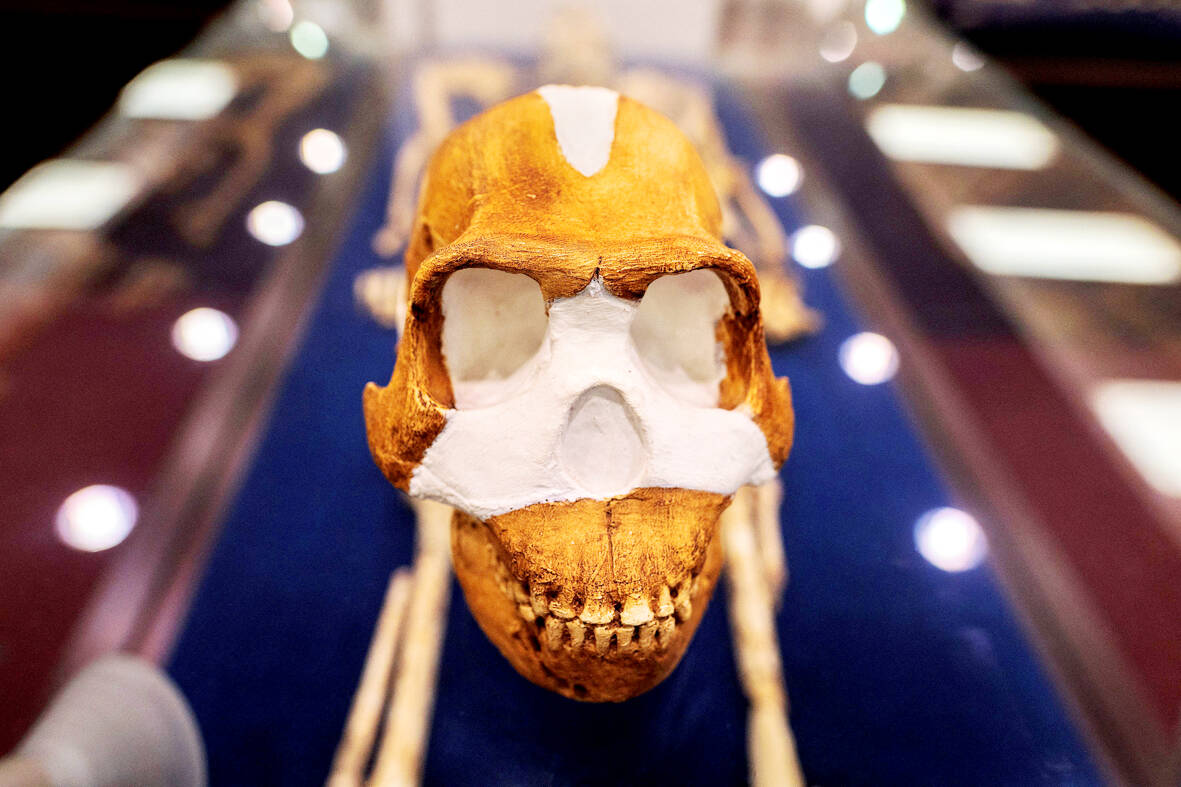An ancient human cousin may have buried its dead and carved symbols into cave walls, surprising findings for a creature with a small brain.
Fossil remains of the species — named Homo naledi — were uncovered in underground caves in South Africa a decade ago. Now, researchers say they’ve found evidence that the species was capable of complex behavior that so far has only been seen in those with bigger brains.
“We are facing a remarkable discovery here” for a species with brains one-third the size of humans, said anthropologist Lee Berger, who led the research funded by the National Geographic Society, where he now works.

Photo: AFP
Berger and colleagues describe their findings in studies posted online Monday. The research has not been peer-reviewed yet and some outside scientists think more evidence is needed to challenge what we know about how humans evolved their complex thinking.
“There’s still a lot to uncover,” said Rick Potts, director of the Smithsonian’s Human Origins Program who was not involved in the research.
H. naledi is a pretty new addition to the family tree of hominins, which includes our direct ancestors and other extinct relatives who walked on two legs. Berger and his team announced the species in 2015, after a tip from local spelunkers led them to the Rising Star cave system near Johannesburg where they uncovered fossils from at least 15 individuals who lived around 300,000 years ago.
These creatures had some traits in common with modern humans, like legs made for walking upright and hands that could work with objects, said University of Wisconsin-Madison anthropologist John Hawks, a member of the research team. But other features looked more ancient, including their small brains.
In recent years, team members have ventured back into the caves, a tricky descent through tight underground spaces. What’s down there shows the species in a new light, they reported.
One of the new studies describes what researchers say were intentional burial sites. The team uncovered fossil remains of adults and children in shallow holes in the ground, their bodies in a fetal position.
Another study describes a series of marks carved into the cave walls, including geometric patterns and cross-hatched lines.
“This is something that takes a lot of time and effort to do,” said Berger, who led the initial research while at the University of the Witwatersrand in Johannesburg.
All of this behavior would be surprising for a creature whose brain was closer in size to an ape’s than a human’s, experts said.
Decades ago, we thought Homo sapiens were the only ones who could figure out how to use fire, bury their dead or create art, said Chris Stringer, a human evolution expert at London’s Natural History Museum who was not involved in the research.
Since then, we’ve learned that other groups like Neanderthals also lived complex lives. But those species still had big brains — unlike H. naledi, whose burials would raise further questions about human evolution, Stringer said.
Scientists haven’t yet been able to identify how old the engravings are. So Potts said the current evidence can’t say for sure whether H. naledi was truly the one to create the symbols, or if some other creature — maybe even H. sapiens — made its way down there at some point.
For study author Agustin Fuentes, an anthropologist at Princeton University, the H. naledi evidence takes the focus off brain size.
“Big brains are still important,” Fuentes said. “They just don’t explain what we thought they explained.”

The Democratic Progressive Party (DPP), Chinese Nationalist Party (KMT), and the country’s other political groups dare not offend religious groups, says Chen Lih-ming (陳立民), founder of the Taiwan Anti-Religion Alliance (台灣反宗教者聯盟). “It’s the same in other democracies, of course, but because political struggles in Taiwan are extraordinarily fierce, you’ll see candidates visiting several temples each day ahead of elections. That adds impetus to religion here,” says the retired college lecturer. In Japan’s most recent election, the Liberal Democratic Party lost many votes because of its ties to the Unification Church (“the Moonies”). Chen contrasts the progress made by anti-religion movements in

Taiwan doesn’t have a lot of railways, but its network has plenty of history. The government-owned entity that last year became the Taiwan Railway Corp (TRC) has been operating trains since 1891. During the 1895-1945 period of Japanese rule, the colonial government made huge investments in rail infrastructure. The northern port city of Keelung was connected to Kaohsiung in the south. New lines appeared in Pingtung, Yilan and the Hualien-Taitung region. Railway enthusiasts exploring Taiwan will find plenty to amuse themselves. Taipei will soon gain its second rail-themed museum. Elsewhere there’s a number of endearing branch lines and rolling-stock collections, some

This was not supposed to be an election year. The local media is billing it as the “2025 great recall era” (2025大罷免時代) or the “2025 great recall wave” (2025大罷免潮), with many now just shortening it to “great recall.” As of this writing the number of campaigns that have submitted the requisite one percent of eligible voters signatures in legislative districts is 51 — 35 targeting Chinese Nationalist Party (KMT) caucus lawmakers and 16 targeting Democratic Progressive Party (DPP) lawmakers. The pan-green side has more as they started earlier. Many recall campaigns are billing themselves as “Winter Bluebirds” after the “Bluebird Action”

Feb 24 to March 2 It’s said that the entire nation came to a standstill every time The Scholar Swordsman (雲州大儒俠) appeared on television. Children skipped school, farmers left the fields and workers went home to watch their hero Shih Yen-wen (史艷文) rid the world of evil in the 30-minute daily glove puppetry show. Even those who didn’t speak Hoklo (commonly known as Taiwanese) were hooked. Running from March 2, 1970 until the government banned it in 1974, the show made Shih a household name and breathed new life into the faltering traditional puppetry industry. It wasn’t the first